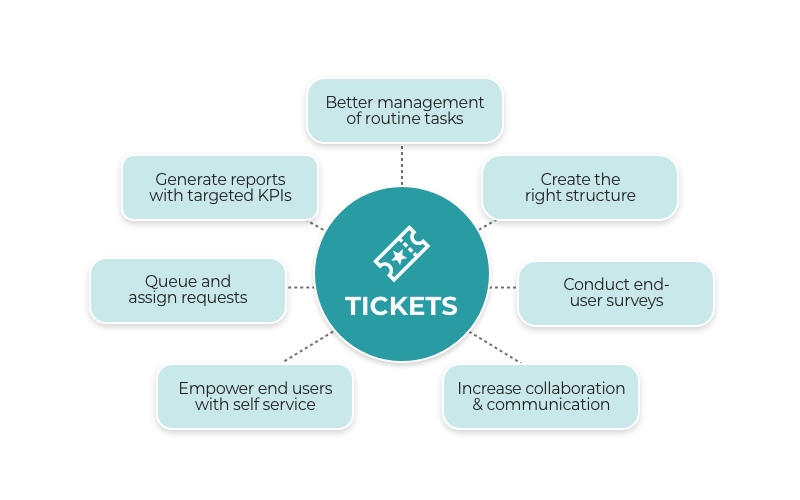“People will soon forget what you said. They will never forget how you made them feel.”- Dr. Maya Angelou”
Waiting, waiting, and more waiting will drive your frustration levels to a new degree. Your customers too, don’t like waiting in long queues to get their queries resolved. The longer you make them wait, the more it hampers your brand image.
Ticket management systems come with features that help your agents in the ticket queue management process and with a swift ticket handling process. Your agents need support automatic ticket assignment process workflows that can ease their task of handling the tickets so that your customer’s complaints are resolved in one go.
What is a customer service ticket?
A customer service ticket is a document that documents a customer’s engagements with a customer support team. When a customer submits a concern, a ticket is generated and shared between the customer and the support representative. The ticket records their interaction on a thread that each party can use as a reference.
A help desk ticketing system can help your agents in managing and handle customer support tickets in an organized and accurate manner. Customers, customer support representatives, and businesses all benefit from support tickets. A support ticket assignment process is an efficient and personalized approach for clients to communicate with support staff and get their concerns resolved.
They can describe their full issue and then provide more specifics as the case progresses. This prevents them from having to repeat crucial information, which is especially useful when working with numerous agents on the same ticket.
Benefits of Automatic Ticket Assignment Process
According to 62% of customers, service insight and knowledge is key to a good customer service experience- American Express
Source: https://www.proprofsdesk.com/blog/help-desk-statistics/
Importance of a proper ticket queue management process?
A proper ticket management process plays an important role in the growth and development of an organization.
Customer service representatives work with the ticket management system to improve customer experience during the resolution process while monitoring essential ticket handling key performance indicators (KPIs) such as ticket responses and resolution timeframes.
An inefficient ticket assignment process can result in SLA (Service Level Agreement) breakdowns when an unresolved Technical problem causes unexpected service downtime that affects the business’s customers.
Lost or mishandled tickets, as well as inappropriate escalations, may all result in extra charges that influence corporate profitability and the overall ROI of service desk operations.
“According to 31% of global respondents, the need to repeat their information multiple times is the most frustrating aspect of their customer service experience- Statista”
Source:https://www.statista.com/statistics/810573/share-of-customers-by-poor-customer-service-experiences/
The best automatic ticket assignment process
Imagine asking a cobbler to fix your fan or an electrician to mend your shoes. Will they be able to do the job assigned to them? The answer is a strict NO! And the reason is that the tasks assigned to them don’t match their skillsets.
Similarly, the assignment of tickets to the agents should be according to their skill sets so that customers’ problems are solved with perfection.A formulated strategy to assign the tickets to the customer support team can be helpful and worthy in the long run.
There are a few tips and tricks to assign tickets to your customer support team that can improve the productivity and efficiency of your agents. Some of them are listed below.
1. Know the case
You can’t solve a problem without knowing the root cause, right? The same is in the case of customer support. The agent needs to be aware of the root cause of the problem faced by the customer, to solve the issue. It is first necessary to understand the issue and the department to which it belongs so that it can be assigned to the right agent in one go.
Service CRM software (Kapture’s One Suite) filters and scans all the keywords reflected in the incoming customer query and assigns it to the most suitable agent. For example, if a customer has a query regarding the refund of a product, then the agent handling the financial complaint will be assigned to the customer. This helps in increasing the productivity and efficiency of the customer support department and more importantly, amps up the CSAT score.
2. Status of the ticket
The agents need to be aware of the status of the ticket to resolve them on time.
It is necessary to provide a particular tag to the ticket for the convenience of the agent.
If you do not establish a status, the ticket processing procedure may become inefficient. The ticket may be unanswered, or the agents’ attempts may be duplicated and nothing is more frustrating than wasting vital time. Keep the status of your ticket visible to the customer care team to guarantee they advance up the line.
There are different statuses which can be given to the tickets according to its situations, they are-
- Open- Tickets having the status “Open” should be responded to as soon as possible. This status indicates that no agent has yet handled the customer’s issue and that they are currently awaiting your answer. Respond to the customer to let them know you’re on your way to handling their matter.
- Pending- Tickets are marked as “Pending” when you are awaiting a response from a client or further input or information before proceeding.
- On hold- A ticket with the status “On hold” indicates that the issue cannot be finished immediately away. This indicates that the customer support representative must discuss the problem with someone on the team or in another department.
- Solved– Mark a ticket as “Solved” when you’re certain you’ve given the client all the information they needed and left them pleased with the end of the chat.
- Closed- There may be occasions when someone gives you a proposal for cooperation or communication with material that isn’t a query or challenge for your team. You can respond to such inquiries briefly and then designate them as “Closed.”
- Spam- The “Spam” status is designated for harmful or otherwise useless queries.
Don’t worry we got your back. Kapture’s One Suite comes with a feature that marks the ticket status and helps agents identify the situation it’s established from.
3. Prioritize the ticket
The customer support team uses ticket priority levels to decide how soon an agent should address a customer care ticket. Customer support teams are driven by priority levels, which are related to the next steps in escalating the issue.
You don’t want your agents all…..
Four types of priority levels define the urgency status of the ticket. They are-
- Urgent
- High
- Medium
- Low
The ticket should be assigned to the agents on this basis so that the most urgent query or complaint is solved in the shortest time possible.
4. Tagging the ticket
A tag helps in defining the department to which the ticket belongs. It helps the agent in getting clarity about the ticket.
There are different types of tags that are used by the ticket management software to simplify the task of the agent. They are-
- Complaint
- Refund
- Billing
- Feedback
- Bug
- Newsletter
- Product Request
- Exchange
- Support
- IT
- Sales
- Marketing
- HR
Tags are also a great way to filter requests and develop automated workflows to speed up the process. These were some of the activities which eases the ticket assignment process.
There are three ways in which the tickets can be assigned to agents.
1. Auto assigning of tickets
Auto assignment of tickets with the help of the ticket management software helps in assigning the tickets to the right agent and saves a lot of time.
There are different methods used by the help desk systems to assign the tickets to the most suitable agents.
- Round robin- This auto-assignment feature allows you to automatically assign agents to tickets in a certain category using an algorithm that seeks to distribute ticket assignments to agents in a circular pattern.
- Round robin and active agents- This auto-assignment occurs when the following two conditions are met: The first is agent availability, and the second is that the quantity of tickets assigned to him does not exceed the throttle limit.
This guarantees that the agent is not allocated tickets when they are offline or when they are loaded with extra tickets.
- Round robin with an active agent with the workload- The algorithm will look for available agents and allocate tickets depending on their current workload.
The ratio of an agent’s currently allocated pending tickets to their Agent Throttle Limit is used to calculate their load. The ticket management system uses its algorithm to assign the tickets to the agents, easing the workload of the customer support department.
2. Manual assignment
This is the most basic and well-known method of assigning tickets to agents. It works by going through the ticket list case by case and allocating each request to an agent. When doing so, you should also consider the agent’s skill set.
Excellent for small-ticket volume. You just have a few tickets to look at, and it only takes a few minutes. As you progress down the list, assigning tickets is simple. A “choose a ticket and pick an agent” strategy.
Agent assignments in certain business scenarios might be random and do not require much attention.
3. Supervision assignment
Another option for allocating tickets is to have them assigned by a supervisor or administrator. Tickets can be assigned to the most experienced support specialist, who is familiar with the customer service team and can properly distribute work and duties.
The supervisor is aware of client types and, as a result, may direct how tickets in the queue should be handled. The supervisor is personally accountable for the customer support workflow and maintains their finger on the pulse of the team. There is no confusion about the information or the distribution of responsibilities.
Agents have faith in their supervisor’s judgments and their growth strategy. Support agents have strong morale since they feel they have the ability to tackle obstacles. These are some of the assignment strategies which can help assign the tickets to the most suitable agents in the customer support team.
Best practices for closing ticket handling process with no customer response
You are aware of the situations in which the customer just forgets to respond to the agent’s question which is essential for the resolution.
There are a few things that can be done to handle these unresponsive customers, they are-
1. Try try and you will succeed or just close
Ask your agents to try asking for a reply for an appropriate amount of time and then just close the ticket so that no one’s time is wasted. The agent can also mark the status of the ticket as pending so that it can be resolved later by some other agent.
2. Automated follow-ups
Some automated replies provided in the ticket management software for closing the tickets can be helpful for the agents for closing an unresponsive ticket.
For example, an automated reply like “ since I am unable to reach you I am closing this query” can be helpful and save the agent’s time.
Assigning tickets can be a tricky job if you don’t have smart ticket management software for your customer support team. Kapture’s One Suite comes with an all-in-one ticket management solution that can give your agents a chill life at work by easing their workload.
,
,
,
,
,
,
,
,
,
,
,
,
,









